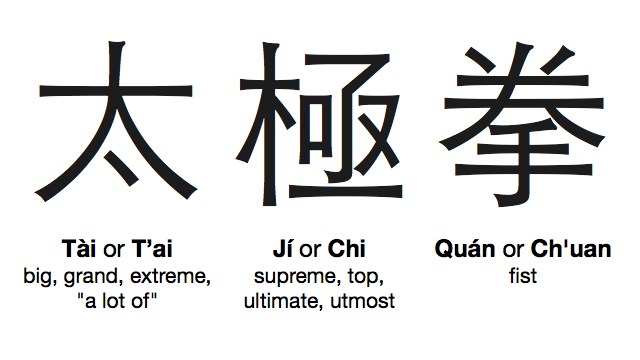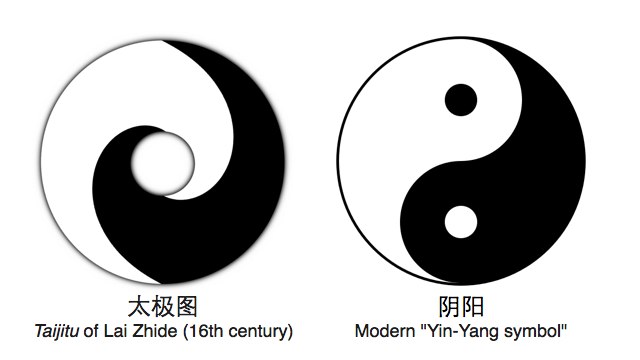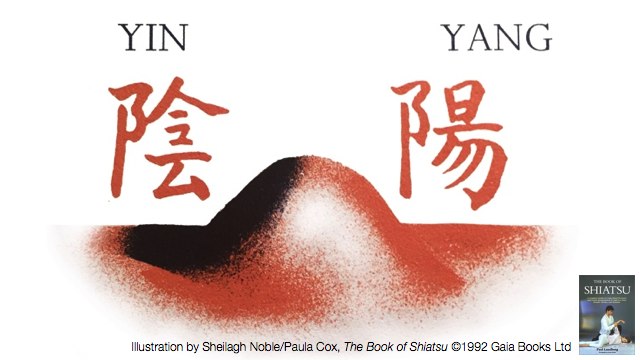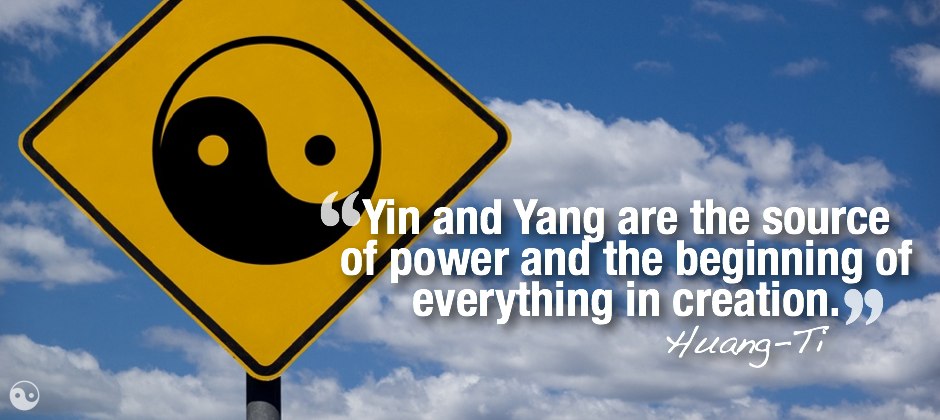The Taiji Principe of Yin and Yang
When reading about Tai Chi, you will find all kinds of spellings, including “Tai Chi,” “T’ai Chi,” and “Taiji.” In this section we’ll go all academic for a moment to clear the confusion, and then go deeper into the mystery of what the phrase Tai Chi actually means or symbolizes.
Written Chinese does not use English (or Roman) letters based on an alphabet of sounds, but rather is written using Chinese characters or Hànzì which symbolize ideas. This can sometimes make it very difficult to translate into English or other Western languages.
One of the first attempts at translation was the Wade-Giles system developed by Thomas Wade and Herbert Giles. The system was codified in the Chinese–English Dictionary published in 1892. In the Wade-Giles system, this martial art was written T’ai Chi Ch’uan.
More recently, the Chinese government published their own system of romanization called Pinyin. It was first published in 1958 and has since been revised several times. Pinyin is the most common way of writing Chinese using the English alphabet in the world today. Our same art in Pinyin would be written Tàijíquán.
For non-Chinese speakers, the accent marks mean very little so they are often dropped. Most commonly you’ll simply see “Tai Chi Chuan” or “Tai Chi” and “Taijiquan” or “Taiji.” While Taijiquan would be the official rendering in China, the rest of the world continues to use the older and far more common Tai Chi Chuan.
We’re going to continue to use “Tai Chi” throughout the Tai Chi Transformation guide, but we’re going to switch to Taiji when speaking about the underlying principle or philosophy. First, let’s break it down to understand an exact translation:

Tai means “Grand” in the sense of awe-inspiring big. Grand as in feeling tiny as you stare up at the vast Milky Way spread of stars on a dark, clear night. Ji is a modifier which means “Ultimate” or supreme or the very top. Quan is easier to translate, as it simply means “Fist,” but also has the meaning of martial art or boxing.
Put together, Tai Chi Chuan or Taijiquan is the most often translated as “Grand Ultimate Fist” or some variation. This has led many Western readers to assume that the name implies that this martial art is the absolute best, the greatest of all other forms of fighting. While some people may make that claim, that’s actually not the intended meaning at all.
With the characters written together, Taiji refers to an ancient Taoist philosophical idea that is at the heart of all existence. It is born out of the concept of Wuji or the ultimate singularity, a cosmic state of non-duality and non-polarity. You could think of it as the state of the universe before the Big Bang, when all things were one, and everything was contained in the single Source.
Taiji is the dynamic force which both breaks apart Wuji and brings all things together again into balance or re-integration. The force of Taiji then is what results in duality or polarity, and this is represented in Taoist philosophy as Yin and Yang, the two opposing but complementary forces in the universe.

The Taiji concept was illustrated many different ways through thousands of years of Chinese philosophical development using a symbol or diagram called the Taijitu. In the Ming era, Lai Zhide (1525–1604) simplified the taijitu to a design of two interlocking spirals. Over the next few generations the taijitu was revised to become the modern Taiji diagram, often called simply the “Yin-Yang” symbol.
The Big Picture
Taiji is the primordial force of both creation and reintegration. When a cell divides and becomes two cells, the force that compelled that division and creation of a new cell is Taiji. The force that compels a spark to become a flame, and a flame to become a blaze is Taiji. On the other side, when a fallen tree softens into a rotten log, then disolves into rich mulch for new plants, that whole dissolution is being pulled along by entropy: the force of Taiji. When a drop of water is absorbed back into the ocean, that reintegration is Taiji.
Taiji is the force, instruction set or magnetic pull behind both creation and reintegration.
The “Quan” or “Chuan” part of the name literally means “fist” but mmore commonly denotes “martial art.” Whenever you see Chuan, Ch’uan or -quan attached to a name, it means “the fighting system of ______.”
“The Fighting System of Taiji” is really nothing more than a label that implies that we’re going to be colliding with other human beings, but with the awareness of this primordial force that’s driving things behind the scenes. That awareness provides a basis for some very interesting martial arts techniques, but to apply them we need to really understand the concepts of Yin and Yang.
Yin and Yang
Yin and Yang are illustrated as the dark and light halves of the taijitu symbol, but the underlying concept is deeper than just “polar opposites” and is fundamental to understanding Taiji. The ideas behind Yin and Yang developed from observing the physical world.
In nature, all things can be grouped into pairs of mutually dependent opposites, each giving meaning to the other. For example, “light” has no meaning without “dark,” “night” has no meaning without “day,” and “up” is meaningless without “down.” All of our ways of labeling and classifying things is dependent upon comparison and contrast.

The Chinese characters for Yin and Yang describe this in a clear, observable way. The character for Yin translates literally as “the dark side of the hill” and represents qualities such as darkness, stillness, cold, passiveness, inside and potential. The character for Yang translates literally as “the bright side of the hill” and represents such qualities as light, activity, heat, aggression, outside and expression.
Unlike Western Aristotelian logic that measures everything in absolute terms, classic Chinese thought puts the emphasis on process instead of structure. Yin and Yang are not absolutes, but simply ways of thinking about the current state. As illustrated in the taijitu, Yin and Yang are constantly in motion, blending one into other like day becoming night. In addition, each quality contains within it the potential of the other (the dots within the symbol), like the wide Yin night sky containing the Yang light of the full moon.
The changing of Yin and Yang phases and the idea of seed potential also lets us subdivide Yin and Yang as our observation “zooms in.” The large stone in a mountain stream would be Yin compared to the Yang flowing water. But water becomes Yin if it freezes into ice, or again Yang if in the form of steam. The water molecule itself contains both Yin particles of protons and neutrons and Yang particles of electrons. Yin and Yang can be found everywhere and in everything.
What is Taiji? It is generated from Wuji, and is a pivotal function of movement and stillness. It is the mother of Yin and Yang. When it moves it divides. At rest it reunites. – Wang, Zong-Yue
In our next lesson, Yin and Yang become important as we describe Taiji principles and Tai Chi movements. We will observe the Yang or active leg and the Yin or resting leg. We will show the Yin energy of absorbing an attacker’s force, as well as the Yang energy of pushing them away. As in nature, Yin and Yang are everywhere in Tai Chi.
Putting It All Together
Now that we understand the concepts of Wuji, Taiji, Yin and Yang, we can apply them to our practice of the Tai Chi form. In the next section, we’re going to walk through the Primal 13 form again, but now begin to apply these concepts along with the Primal 13 forces of the Five Steps and the Eight Energies.

